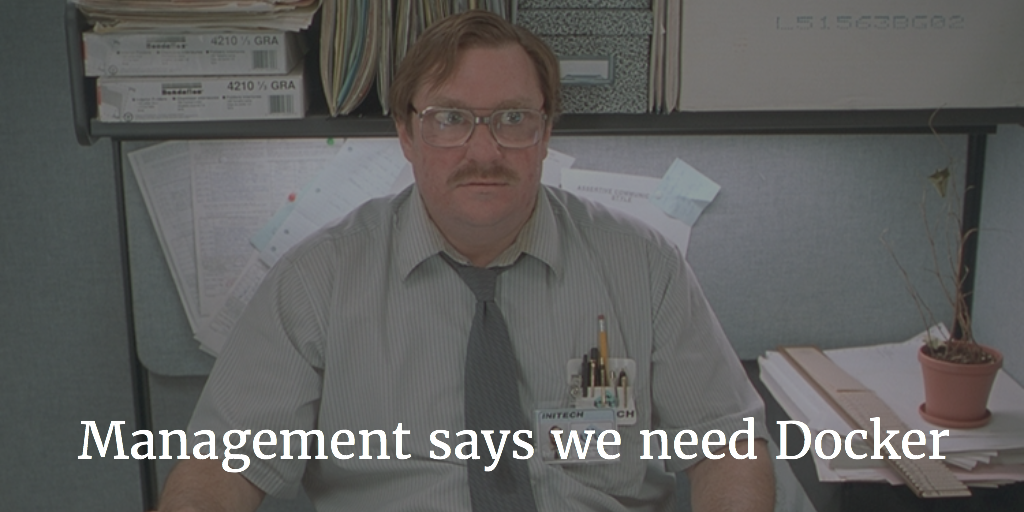How to Create a Docker Business Case
Learn how to create a compelling Docker business case. This guide covers key elements, cost-saving benefits, risk mitigation, and how to measure the ROI of adopting Docker in your organization.

Like many of you, upper management types constantly ask me to describe Docker.
The questions they ask range from "What is Docker?" to "How will Docker benefit my business or team?" and "How much does it cost?"
It's easy to jump right into the technical benefits of Docker. However, many times with management, you will quickly notice their eyes gloss over or roll back in their heads and give you that deer in the headlight look as you excitedly describe how to push a container or explain your favorite CI/CD workflows.

Put on your management hat and backup. Describe Docker from a very high level view. What has worked well is presenting a diagram of the comparison between a VM and a Docker container so your audience can visualize Docker.
Next, describe the large community behind Docker and demo Docker Hub. Finally, install a WordPress container or any image you like as a quick demo on a server local in your office.
At this point your audience is usually hooked into your conversation. Now, we need to start building our Docker business case on why you need Docker for XYZ.
Here's where we transition into a sales role.
Put on your sales hat on as we are now going to discuss how Docker will reduce costs, standardize our infrastructure, and consolidate resources all while reducing time to market on delivering your company's product or service.
Cost Reduction
What drives most management decisions when selecting a new product? Reducing costs yet raising profits, all while staying within budget, is the usual suspect.
You may ask how Docker can reduce costs. Docker enables businesses to optimize infrastructure resources, standardize environments, and reduce time to market.
Flexibility is also a huge cost-saving tool. Docker enables users to run their containers wherever they please, either in a Cloud or on-premise. You ask how I can save money with flexibility. No more vendor or Cloud lock-ins. Move your containers to any Docker host on any infrastructure from Amazon, Google, or Azure to the server under your desk.
Standardization
Whether a container is running in a Cloud or on a laptop, Docker makes it easy to standardize your environments from Development to Production. Package your application and all its dependencies into a single container, which removes common inconsistencies between Development and Production and allows you to run the same container in any environment.
Easily reproduce production or test environments and set up and distribute new environments. This allows for standardized environments which can be easily managed and updated.
Ressource Consolidation
No longer is it required to run a separate VM per application. Now, Docker empowers you to run as many containers as your infrastructure can handle.
During my DockerCon presentationcould, I presented an actual use case where we had a Database as a Service where every Database was provisioned inside its own VM. At one point, we had upwards of 200 VMs running 200 Databases. This was not only expensive both from a resource and cost perspective, but it was also extremely inefficient.
After moving to Docker, we could consolidate the 200 Databases into 200 Docker containers running on just 20 VMs. This instantly reduced costs, and at the same time, our infrastructure became easier to manage.
Did I mention this saved us money?
Time to Market
Time is something we can never get back. However, Docker reduces the amount of time it takes to install an application, scale to meet customer demands or simply start new containers. Every precious second that you can save is also money saved. Now you determine when when your product is available on the market and not your infrastructure.
Docker also easily integrates into all the popular Continuous Integration/Continuous Delivery pipelines, enabling Development and Testing to deliver seamless updates to production much more efficiently. However, in the event of a problem you can now easily roll back to the previous version as quick as as it was installed intially. Even in failure situations it is easy and quick to rollback.
Conclusion
I've pitched Docker many times from large corporations with huge development teams to single developers and everything in between. What is common between the different pitches is everyone is interested in solving their particular problem. These problems I find are always unique to the person, project, or company. For example, I have X application I need to deploy in a standard environment, or I need a test, dev, and production CI/CD, or improve infrastructure efficiency, etc etc. Be sure to adapt your business case to your audience and do your homework.
Docker is not just a tool but a tool belt that helps drive down costs, standardize, consolidate resources, and reduce time to market.
FAQ Section: How to Create a Docker Business Case
What is a Docker business case, and why is it important?
A Docker business case is a detailed proposal that outlines the benefits, costs, and potential ROI of adopting Docker within an organization. It’s important because it helps decision-makers understand the value Docker can bring, such as improved efficiency, scalability, and reduced costs, thereby justifying the investment in containerization technology.
What key elements should be included in a Docker business case?
A comprehensive Docker business case should include the following key elements: an executive summary, a problem statement, potential Docker solutions, benefits (such as cost savings, improved deployment speed, and scalability), implementation costs, risks and mitigation strategies, and a conclusion that supports the decision to adopt Docker.
How can Docker reduce costs for businesses?
Docker can reduce costs by optimizing resource usage, minimizing server requirements, and improving deployment efficiency. Docker containers use less overhead compared to traditional virtual machines, allowing businesses to run more applications on fewer servers. This leads to savings on hardware, maintenance, and energy costs.
What are the potential risks of adopting Docker, and how can they be mitigated?
Potential risks of adopting Docker include security concerns, complexity in managing containers, and the need for skilled personnel. These risks can be mitigated by implementing robust security practices, using Docker orchestration tools (like Kubernetes) to manage containerized applications, and investing in training for staff to ensure they have the necessary skills.
How do you measure the ROI of Docker adoption?
The ROI of Docker adoption can be measured by comparing the initial and ongoing costs of implementation with the financial benefits realized through increased efficiency, reduced downtime, faster deployment times, and lower infrastructure costs. Tracking metrics like time to market, application performance, and resource utilization before and after Docker implementation can provide a clear picture of its impact.
Follow me
If you liked this article, Follow Me on Twitter to stay updated!



